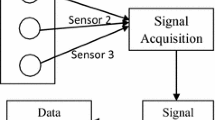Abstract
In this letter, we present a novel approach of valve stiction detection using wavelet technology. A new non-invasive method is developed with the closed-loop normal operating data. The redundant dyadic discrete wavelet transform is used to decompose the data at different resolution scales. Based on the Lipschitz regularity theory, wavelet coefficients analysis across scales is performed to detect the jumps in the controlled variables. Adaptive wavelet de-noising is then applied to the data. Features of the valve stiction patterns are extracted from the de-noised data and the valve stiction probability is calculated.
Similar content being viewed by others
References
L. Desborough and R. Miller. Increasing customer value of industrial control performance montoring — Honeywell’s experience. Chemical Process Control-V, 326(2001)98, 153–185.
Y. Yamashita. Diagnosis quantification of control valves. Society of Instrument and Control Engineers (SICE) Annual Conference, Tokyo, Aug. 20–22, 2008, 2108–2111.
R. Srinivasan, R. Rengaswamy, U. Nallasivam, et al. Issues in modeling stiction in process control valves. American Control Conference, Seattle, WA, June 11–13, 2008, 3374–3379
R. Srinivasan and R. Rengaswamy. Control loop performance assessment. 1. A qualitative approach for stiction diagnosis. Industrial and Engineering Chemistry Research, 44(2005)17, 6708–6718.
R. Srinivasan and R. Rengaswamy. Control loop performance assessment. 2. Hammerstein model approach for stiction diagnosis. Industrial and Engineering Chemistry Research, 44(2005)17, 6719–6728.
M. S. Choudhurya, S. Shaha, N. Thornhillb, and D. S. Shook, Automatic detection and quantification of stiction in control valves. Control Engineering Practice, 14(2006)12, 1395–1412.
Y. T. Chan. Wavelet Basics. 1st ed., Holland, Kluwer Academic Publichers, 1995, 77–81.
S. Mallat. A Wavelet Tour of Signal Processing. 2nd ed., America, Academic Press, 1999.
M. J. Shensa. The discrete wavelet transform: wedding the a trous and Mallat algorithms. IEEE Transactions on Signal Processing, 40(1992)10, 2464–2482.
Hui-Guang Li, Chang-Ping Sun, Yang Li, et al.. A new discrete wavelet transform fast algorithm with rational dilation factor. Wavelet Analysis and Pattern Recognition 2007, Beijing, China, Nov. 2–4, Vol.4, 1600–1603.
P. H. Cox and A. A. Carvalho. Discrete wavelet transform signal analyzer. Instrumentation and Measurement, 56(2007), 1640–1647.
Y. Xu, J. B. Weaver, D. M. Healy, and J. Lu. Wavelet transform domain filters: a spatially selective noise filtration techniques. IEEE Transactions on Image Processing, 3(1994)6, 747–758.
Author information
Authors and Affiliations
Corresponding author
Additional information
Supported by the National High-Tech Research and Development Plan (863) of China (No.2006AA01Z232, No.2009AA01Z212, No.200901Z202), the Natural Science Foundation of Jiangsu Province (No. BK2007603), High-Tech Research Plan of Jiangsu Province (No.BG2007045), Research Climbing Project of NJUPT (No.NY2007044) and Foundation of Nanjing University of Information Science and Technology(No.20070025).
Communication author: Xu Zhanyang, born in 1975, male, Ph.D. candidate, lectorate.
About this article
Cite this article
Xu, Z., Zhan, C. & Zhang, S. A new non-invasive method for valve stiction dection using wavelet technology. J. Electron.(China) 26, 673–680 (2009). https://doi.org/10.1007/s11767-009-0017-3
Received:
Revised:
Published:
Issue Date:
DOI: https://doi.org/10.1007/s11767-009-0017-3




